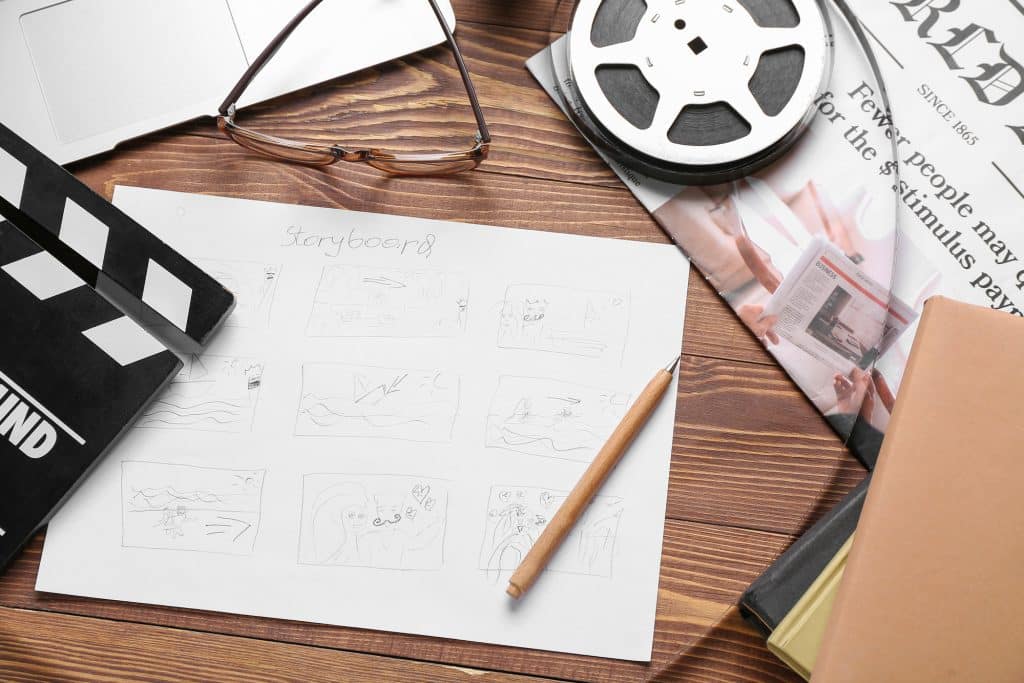Storyboarding is a great way to organize your ideas, but let’s face it: storyboarding takes a lot of time to get the job done. And in today’s fast-paced world, it’s important to be efficient. So, in this article, we’ll share six simple tips to help you speed up your storyboarding process. Hold tight, and be ready for faster storyboarding!
-
Plan Before Sketching

Before you start sketching, take some time to plan out your storyboard. Consider what your goal is for your project and what message you want to convey. Think about the key elements you want to include and how they will fit together to tell your story effectively. Prepare the following things before you begin sketching:
- Define the purpose and main message of your storyboard.
- Identify the key scenes and characters that will drive your narrative.
- Outline the sequence of events to ensure a logical flow of the story.
- Consider the visual style and aesthetics that will best represent your storyline.
-
Use Digital Tools

While traditional storyboarding is effective, using digital tools can help you work faster. And there are many helpful digital tools available today. One of these is the AI storyboard generator, which can create storyboards with just a few clicks. This makes it great for anyone who wants to save time. Here’s why you should give it a try:
- Saves Time: AI storyboard generators create multiple storyboards quickly compared to manual hand-drawn methods, saving you valuable time.
- Easy to Use: These tools are simple and user-friendly, suitable for both beginners and experienced creators.
- Cost-Effective: Using an AI storyboard generator can be a budget-friendly option, especially for projects with limited resources.
- Accessible Online: Many AI storyboard generators are available online, so you can use them without downloading anything.
- Efficient Editing: AI-powered tools allow for quick changes, making it easy to refine and adjust your storyboards as needed.
-
Utilize Templates

Using templates can make your storyboarding faster. If you have templates from a previous project, use them to your advantage. They help maintain a consistent look and structure, saving you time when starting new storyboards. Here are some common types of templates you can utilize:
- Storyboard Layouts: Using a pre-designed template with designated frames and spaces for images and text can expedite the process of arranging scenes and visual elements.
- Character Templates: Pre-existing character templates, including various poses and expressions, can streamline the depiction of consistent characters throughout the storyboard.
- Background Templates: Templates featuring different settings and backgrounds can be reused to maintain a consistent visual environment and save time on creating new backgrounds for each frame.
- Storyboard Sequence Templates: Templates outlining standard sequences for different types of stories (e.g., action, drama, comedy) can serve as a blueprint for organizing scenes in a cohesive and engaging narrative flow.
-
Organize Storyboard Elements Clearly
Organizing your storyboard elements is crucial for faster storyboarding. Clear scenes, characters, and details make the narrative more engaging and help your team work efficiently. Consider the following:
- Provide a clear visual guide for scriptwriters, ensuring a seamless alignment between transitions and dialogue.
- Offer well-structured elements for artists and illustrators, helping them accurately interpret and depict scenes.
- Create a reliable reference for editors and the post-production team, simplifying the editing process and preserving the initial vision.
-
Incorporate Feedback Early On
Getting feedback early on in your storyboarding process can be really helpful. It allows you to catch any issues or make improvements sooner rather than later, saving you time and effort. By having open discussions with your team at the beginning, you can make your storyboard better and make sure it gets your message across clearly. Early feedback helps you work more efficiently and collaboratively on your storyboard. Here are some aspects to consider when seeking feedback:
- Clarity of Message: Ensure that the central message of your storyboard is clear and effectively communicated to the audience.
- Visual Coherence: Confirm that the visual elements and scenes align coherently with the overall narrative and contribute to a seamless storytelling experience.
- Character Consistency: Check whether the characters’ actions, emotions, and appearances remain consistent throughout the storyboard.
- Pacing and Flow: Evaluate the pacing and flow of the storyboard to guarantee that the story unfolds logically and engages the audience effectively.
- Emotional Impact: Assess whether the storyboard effectively evokes the intended emotions and responses from the audience at different stages of the narrative
This clarity helps you avoid confusion and saves time that might otherwise be spent on correcting mistakes or making last-minute changes.
-
Maintain a Streamlined Workflow
To speed up your storyboarding, it’s crucial to keep your workflow organized. Here’s how you can do it:
- Plan First: Don’t rush into the first draft. Take the time to finalize your plan before starting.
- Assign Tasks: Make sure everyone in your team knows what they’re responsible for.
- Choose Your Tools: Decide whether you’ll work digitally or traditionally and pick the right tools accordingly.
- Prepare Templates: Have your templates ready in advance to make the process smoother.
- Stick to Your Plan: Stay consistent and follow your established workflow to keep things on track.
When everything is organized, you can work more efficiently and finish your storyboards faster.
Conclusion
In conclusion, there are many ways to speed up your storyboarding process. With the tips we’ve discussed, it’s up to you to choose the ones that suit you best. Try out these techniques to bring your creative ideas to life more easily.
